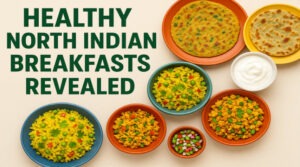Parathas sizzling in ghee, masala chai brewing on the stove — it’s a North Indian morning classic. But what if we told you that some traditional North Indian breakfasts can be as nourishing as they are comforting? Let’s uncover the healthiest breakfast items for North Indians, backed by science, and learn how to make your favorites guilt-free.
Why North Indian breakfasts matter for health
Breakfasts in North India are often rich in carbohydrates, dairy, and fats — foods that provide warmth and energy. However, the challenge lies in balancing taste with nutrition. Modern versions of parathas and halwas have become heavier with refined flour and ghee. Yet, traditional grains like millets, whole wheat, and lentils can turn these same meals into nutrient powerhouses.

A study from the Indian Journal of Nutrition and Dietetics (2022) found that incorporating whole grains and pulses in North Indian breakfasts improves blood sugar control and satiety.
Top Healthiest North Indian Breakfast Items
1. Stuffed Multigrain Paratha (with minimal ghee)
- Why it’s good: A traditional paratha made with whole wheat, jowar, or bajra flour provides complex carbs and fiber. Stuffing it with paneer, spinach, or methi boosts protein and micronutrients.
- How to make it healthier: Use olive oil or minimal ghee for cooking, and serve with plain low-fat curd instead of butter.
- Science-backed: Diets rich in whole grains and legumes reduce risks of obesity and heart disease.
2. Vegetable Poha or Daliya (Broken Wheat Upma)
- Why it’s good: Poha made from flattened rice and vegetables offers easily digestible carbohydrates and fiber. Daliya, on the other hand, is a slow-digesting grain that sustains energy for hours.
- How to make it healthier: Add peas, carrots, spinach, and sprinkle flaxseeds or roasted peanuts for crunch and omega-3s.
- Bonus: Both are light yet filling — ideal for people with diabetes or weight goals.
3. Besan Chilla (Gram Flour Pancake)
- Why it’s good: Made with chickpea flour, besan chilla is high in protein, iron, and magnesium. It’s gluten-free and low in glycemic index.
- How to boost it: Add chopped vegetables like onions, spinach, and bell peppers. Serve with mint chutney or curd.
- Research insight: Legume-based breakfasts improve satiety and reduce cravings later in the day.
4. Sprouted Moong Salad or Chaat
- Why it’s good: Sprouting increases vitamin C and B-complex levels and improves protein digestibility. Moong sprouts provide plant-based protein and fiber.
- How to make it healthier: Add diced cucumber, tomato, coriander, and lemon juice; avoid fried papdi or sev.
- Pro tip: Perfect as a light breakfast or pre-workout snack.
5. Idli, Dosa, or Uttapam (North Indian Twist)
- Why it’s good: Fermented batters are probiotic-rich and improve gut health. Many North Indian homes now use millet-based batters for added fiber.
- Smart variation: Try ragi dosa or oats uttapam for more nutrition. Pair with sambhar and light chutney.
6. Paneer Bhurji with Whole Wheat Toast or Roti
- Why it’s good: A rich source of protein and calcium, paneer bhurji is satiating and supports muscle recovery.
- How to boost it: Use minimal oil; add tomatoes, onions, capsicum, and turmeric for antioxidants.
- Alternate: Tofu bhurji is a lighter, vegan option with similar texture and higher unsaturated fats.
7. Millet Upma / Ragi Porridge / Oats Kheer (without sugar)
- Why it’s good: Replacing refined grains with millets (like foxtail, barnyard, or ragi) adds fiber, magnesium, and plant-based protein.
- Smart tip: Sweeten with dates or jaggery; top with nuts and cardamom for flavor.
Traditional Items to Enjoy Occasionally
- Aloo Poori / Halwa-Puri: Delicious but high in oil and refined flour — keep for festivals only.
- Parathas with butter / kachoris / jalebi: High saturated fat; better as rare treats, not daily breakfasts.
Healthy Beverage Pairings
- Masala Chai (with less sugar and low-fat milk)
- Lukewarm water with lemon & chia seeds for digestion
- Turmeric or ginger milk for immunity
- Unsweetened lassi or buttermilk as a probiotic drink
The Nutrition Blueprint for a North Indian Breakfast
| Component | Example | Benefit |
|---|---|---|
| Whole Grain Base | Millet roti, poha, daliya | Sustained energy |
| Protein Source | Paneer, lentils, sprouts | Satiety & muscle health |
| Healthy Fat | Ghee (1 tsp), nuts | Hormonal balance |
| Fruits/Veggies | Seasonal produce | Vitamins & antioxidants |
Verdict
The healthiest North Indian breakfasts blend heritage with science — think besan chilla, millet paratha, and moong sprouts instead of fried snacks. With small tweaks like whole grains, low oil, and natural sweeteners, you can enjoy authentic flavors without compromising on health.
Leave a Reply